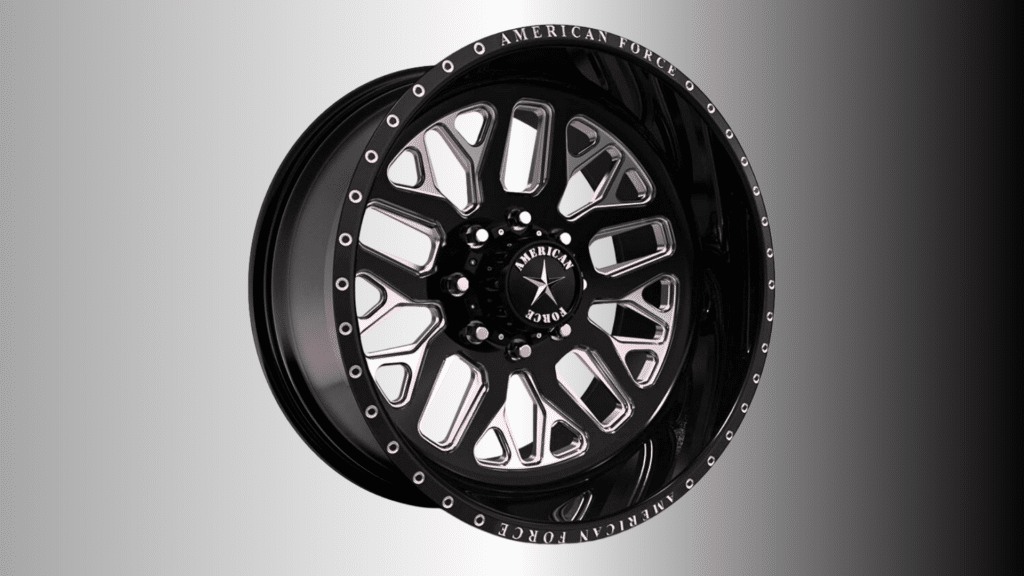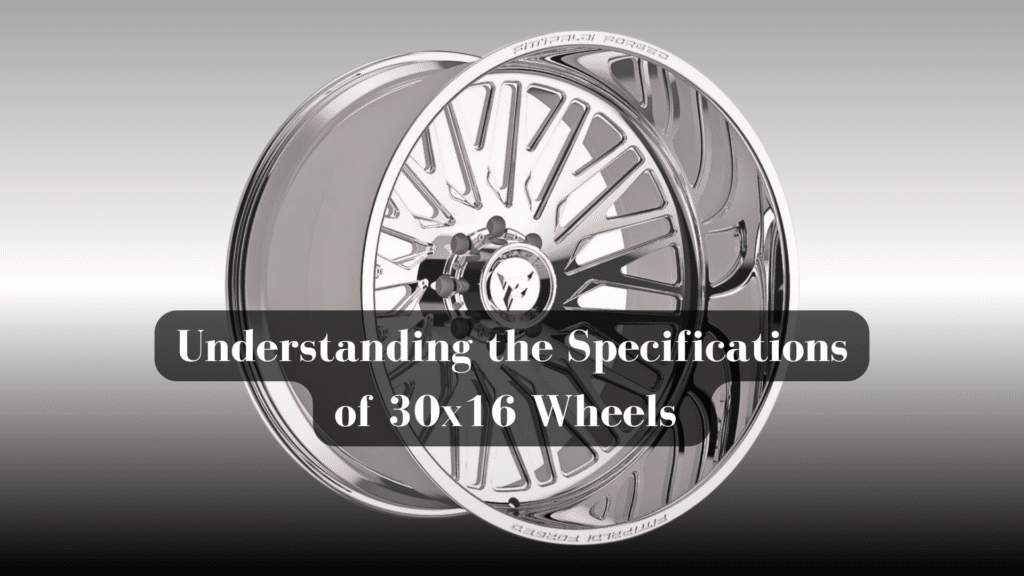30×16 wheels can greatly improve the appearance and performance of your vehicle.
These large wheels, measuring 30 inches in diameter and 16 inches in width, are becoming more popular among truck and SUV owners.
Why should you care about their specs?
Well, putting the wrong wheels on your vehicle can cause problems with handling, fuel use, and safety.
You might also waste money on wheels that don’t fit or work with your vehicle.
In this guide, we’ll explain everything you need about 30×16 wheels. You’ll learn:
- What makes these wheels special
- How to check if they’ll fit your vehicle
- Common mistakes to avoid
I’ve spent years working with different wheel sizes and setups.
By the end of this article, you’ll know how to make a smart choice about 30×16 wheels for your vehicle.
Features to Look for in 30×16 Wheels

Let me start with the most important part – what these wheels are made of. You can choose between two main materials:
Aluminum Alloy Wheels
These wheels are light and won’t rust.
They help your car use less gas because they don’t weigh much.
But they can bend if you hit something hard.
Steel Wheels
Steel is heavier but stronger. These wheels cost less and can take more damage.
The downside?
They rust if you don’t take care of them.
How Much Weight Can They Handle?
Check the load rating—it’s that simple.
Look at your car’s manual to find out how much weight your wheels need to support.
Just to be safe, buy wheels that can handle more weight than you need.
Understanding Offset and Backspacing
Here’s what these terms mean in plain English:
- Offset tells you how far in or out your wheel sits
- Backspacing shows the distance from the back of the wheel to where it mounts
Looking Good Matters Too
You can pick from:
- Simple spoke designs
- Detailed patterns
- Different finishes (shiny, matte, or black)
But remember—looks come second. First, ensure the wheels fit right and support your vehicle’s weight.
Popular Vehicle Models That Use 30×16 Wheels
Let me tell you which vehicles work best with 30×16 wheels.
Not every car can handle these big wheels, but many larger vehicles can.
Trucks That Fit These Wheels
I’ve seen these wheels work great on:
- Ford F-250 and F-350
- Chevrolet Silverado 2500
- RAM 2500 and 3500
- GMC Sierra HD
SUVs That Can Use 30x16s
These big SUVs have the space for 30×16 wheels:
- Ford Expedition
- Chevrolet Tahoe
- Toyota Sequoia
- Nissan Armada
What Makes a Vehicle Compatible?
Your vehicle needs:
- Big enough wheel wells
- Strong suspension
- Proper brake clearance
- Enough power to turn these big wheels
Special Note About Modifications
You might need to lift your vehicle to fit these wheels.
I always tell people to check their owner’s manual first.
Some vehicles need extra parts to make these wheels work right.
Brand Differences
Ford and Chevy trucks usually need fewer changes to fit these wheels.
Toyota and Nissan might need more work.
Each brand has its own way of building vehicles, so what works on one might not work on another.
Benefits of Upgrading to 30×16 Wheels
Let me share what makes these wheels worth considering.
I’ve helped many vehicle owners make this change, and here’s what you’ll get:
Better Grip and Stability
These wide wheels give you more rubber on the road. This means:
- Better control when turning
- Shorter stopping distance
- More stable handling at high speeds
- Better traction in wet conditions
Off-Road Performance
If you like driving off the beaten path, you’ll notice:
- Better grip on rough terrain
- More control in mud and sand
- Less chance of getting stuck
- Better rock-climbing ability
Looks That Turn Heads
Big wheels make a big difference in how your vehicle looks:
- They fill out wheel wells completely
- Give your vehicle a stronger stance
- Let you pick from many style options
- Make your vehicle stand out
Money Matters
These wheels can help your wallet, too:
- They often boost resale value
- Quality wheels last longer
- They attract more buyers when selling
- Good wheels hold their value well
But here’s the truth: while these benefits are real, ensure the upgrade makes sense for your vehicle use.
Not everyone needs 30×16 wheels, but those who do usually love them.
Comparing 30×16 Wheels to Other Bolt Patterns
First, let me explain what a bolt pattern is.
It’s the way your wheel attaches to your vehicle—think of it as the fingerprint of your wheel setup.
The number and spacing of these bolts must match your vehicle perfectly.
| Feature | 30×16 Wheels | 28×14 Wheels | 32×18 Wheels |
|---|---|---|---|
| Common Bolt Patterns | 8×6.5, 8×170 | 6×5.5, 6×135 | 8×6.5, 8×170 |
| Vehicle Types | Heavy trucks, Large SUVs | Mid-size trucks, SUVs | Custom trucks |
| Pros |
– Strong grip – Stable handling – Good load capacity |
– More tire options – Lower cost – Better fuel use |
– Maximum grip – Best look – Ultimate strength |
| Cons |
– Higher cost – Fewer tire choices – May need vehicle changes |
– Less grip – Smaller look |
– Very expensive – Hard to find parts – Major changes needed |
| Typical Cost | $200-400 per wheel | $150-300 per wheel | $300-600 per wheel |
| Installation Ease | Medium | Easy | Hard |
| Weight Rating | Up to 4,000 lbs | Up to 3,000 lbs | Up to 5,000 lbs |
How to Maintain and Care for 30×16 Wheels
Regular Cleaning and Protection
Keeping your 30×16 wheels clean is the first step to making them last.
I recommend using simple soap and water every two weeks.
Start at the top and work your way down, getting into all the small spaces with a soft brush.
Once clean, dry them immediately with a clean cloth to prevent water spots and rust.
Spotting Damage Early
Checking your wheels for damage should become part of your routine.
Each month, examine them closely in good light.
Run your hand over the surface to feel for rough spots or cracks.
If you ignore small problems, they can become big ones. I’ve seen tiny cracks lead to wheel failure, so don’t skip this step.
Proper Mounting and Balancing
The right balance makes all the difference in how your wheels perform.
Get them balanced every 6,000 miles or when you notice your steering wheel shaking.
Also, pay attention to how your vehicle drives. If it pulls to one side or makes odd noises, get your wheels checked immediately.
Seasonal Care Tips
Winter brings special challenges for wheel care.
If you let it sit, salt on the roads can eat away at your wheels.
Wash your wheels weekly during winter months and apply a protection spray to keep the salt from sticking.
In summer, watch out for brake dust buildup and check your tire pressure more often,, as heat affects pressure levels.
Tips for Choosing the Right 30×16 Wheels
1. Check Your Vehicle First
Before you spend any money, let me help you check if these wheels will work on your vehicle.
Look at your owner’s manual for the maximum wheel size.
Some vehicles need extra parts to fit 30×16 wheels.
I’ve seen many people buy wheels that don’t fit, and that’s just wasting money.
Write down your vehicle’s bolt pattern and offset numbers before shopping.
2. Think About How You Drive
Tell me how you use your vehicle.
If you drive mostly on roads, you’ll want wheels that are different from those of someone who goes off-road often.
Street driving needs lighter wheels for better gas mileage.
Off-road use needs stronger wheels that can take hits from rocks and rough terrain.
Mixed use? Look for wheels that work well in both settings.
3. Set a Smart Budget
Good 30×16 wheels aren’t cheap, but they don’t have to break the bank.
I suggest setting aside $800 to $2,000 for a full set.
Remember to include money for tires, installation, and any extra parts you might need.
Cheaper isn’t always better – I’ve seen low-cost wheels crack under normal use.
4. Pick the Right Finish
The finish affects how long your wheels last.
The paint looks nice but chips easily. Powder coating costs more but lasts longer.
Chrome looks shiny but needs lots of care. Black wheels hide dirt better but show scratches more.
Think about how much time you want to spend cleaning and maintaining your wheels.
5. Choose Where to Buy
Here’s what I know about different sellers.
Car dealers charge more but offer better warranties.
Online stores have lower prices, but you can’t see the wheels in person.
Local wheel shops let you see and touch the wheels, plus they often include installation.
I recommend visiting a local shop first to learn about different options, even if you buy online later.
Remember to get a warranty no matter where you buy.
A good wheel shop will help you pick wheels that match your needs and budget.
Conclusion
Now you know what makes 30×16 wheels special.
You’ve learned about materials, fits, and how to care for them.
Before you buy, ask yourself:
- Does your vehicle support these wheels?
- Will they match how you use your vehicle?
- Can you maintain them properly?
I’ve helped many people choose wheels, and here’s my best tip: take your time.
Research different brands, talk to other owners, and visit local shops.
The right wheels will improve your vehicle in every way.
Need more help?
Your local wheel shop or mechanic can answer specific questions about your vehicle.
They’ll make sure you get wheels that work great for you.
Frequently Asked Questions
How Much Do 30×16 Wheels Typically Weigh?
Depending on the material, a 30×16 wheel weighs between 40 and 55 pounds.
Aluminum wheels are lighter, while steel can weigh up to 15 pounds more.
Can I Put 30×16 Wheels On My Stock Suspension?
Most vehicles need a 2-inch lift kit to properly fit 30×16 wheels.
Running them on stock suspension can damage the vehicle’s components.
Will 30×16 Wheels Affect My Fuel Economy?
These wheels can lower your fuel economy by 2-4 miles per gallon.
Because they’re heavier and wider than standard wheels, creating more rolling resistance.


